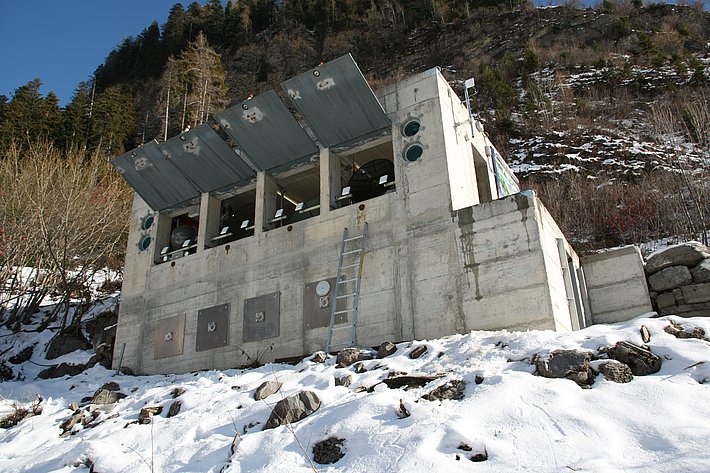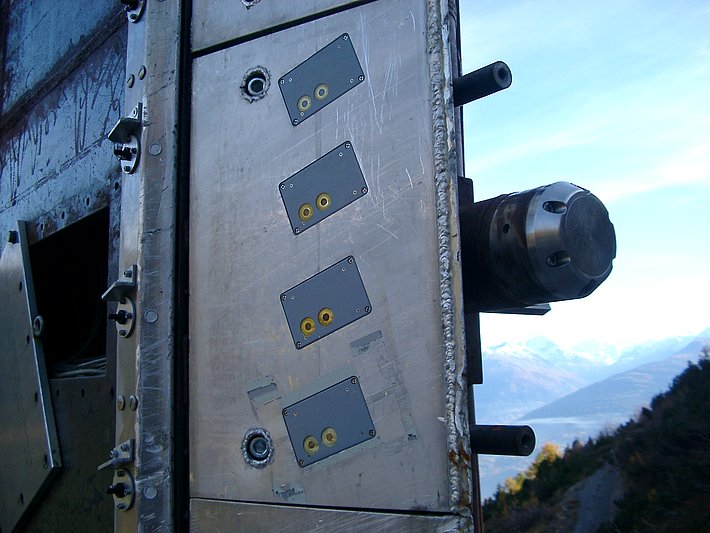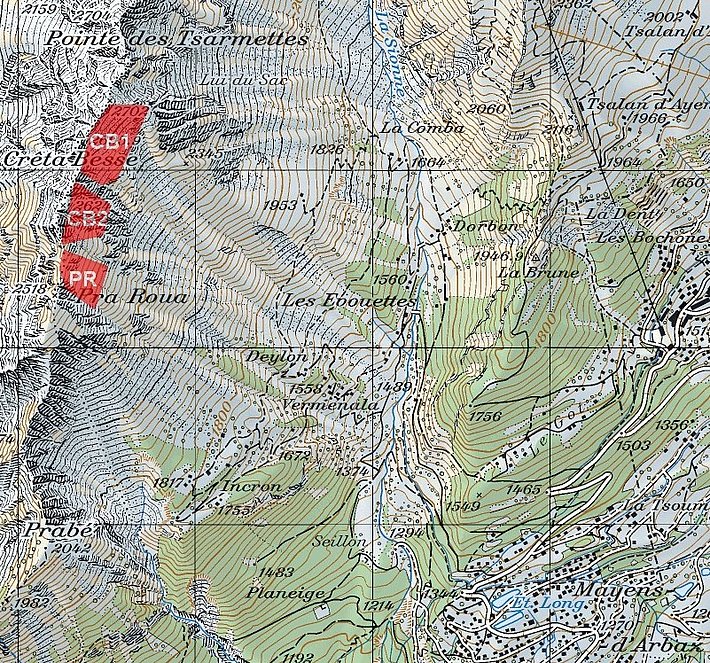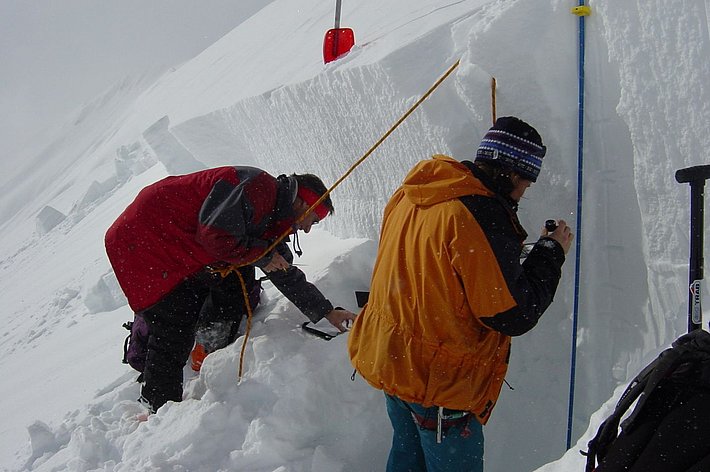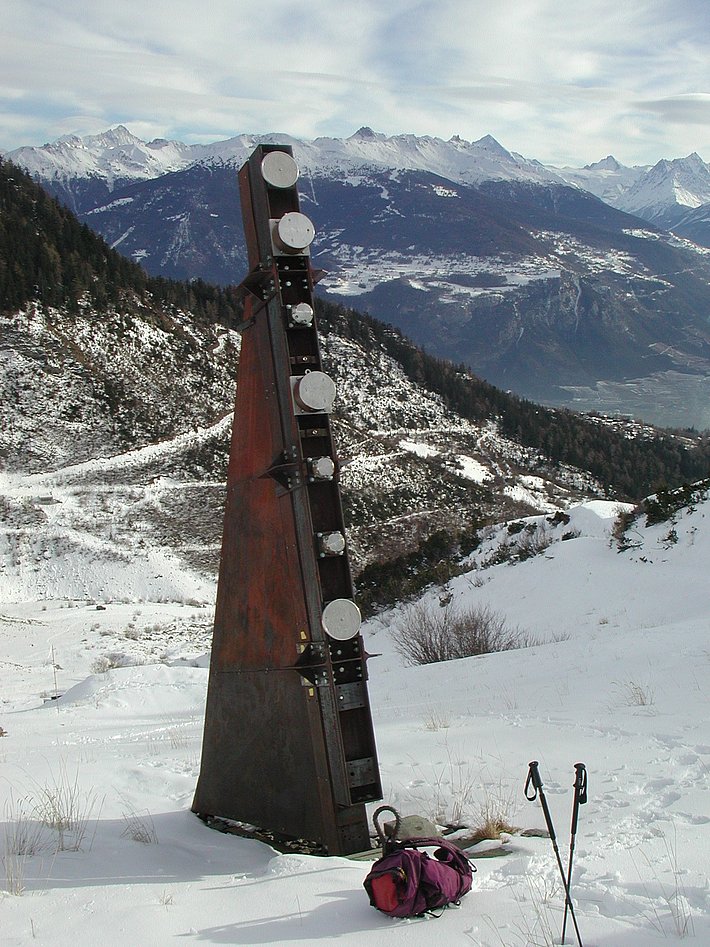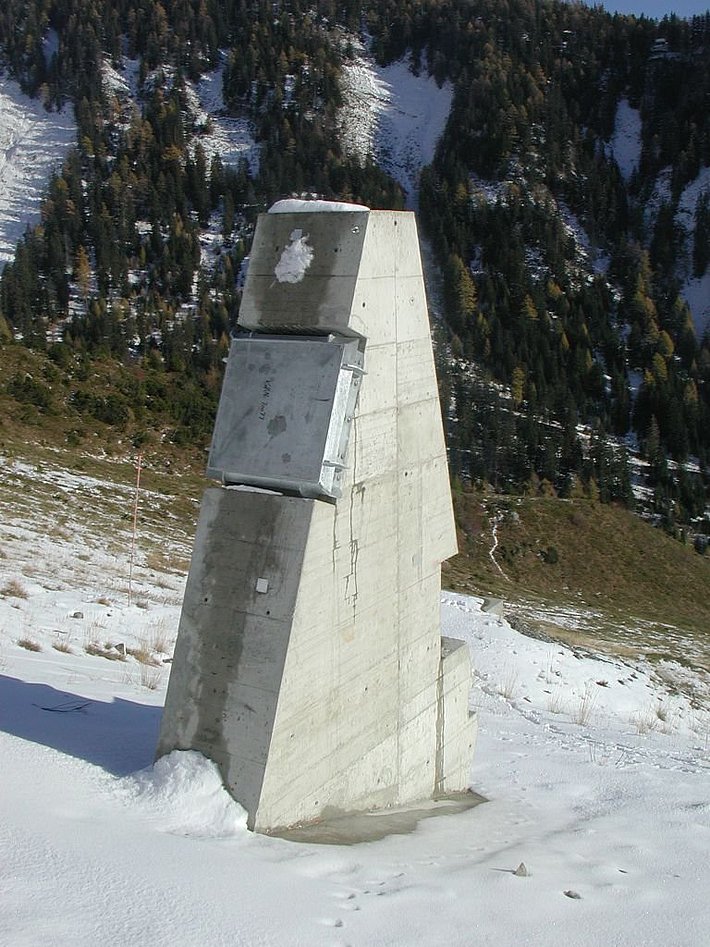
Avalanche test site ¶
Investigating snow avalanche dynamics at the full-scale test-site: Vallée de la Sionne / Cmne d'Arbaz, Valais ¶
The full-scale avalanche dynamics test site Vallée de la Sionne (VdlS) is providing scientists and engineers with essential data to understand and model avalanche motion.
The site has been in operation since the winter 1997/98 and represents the cornerstone of snow avalanche dynamics research at the SLF. Partly destroyed by the extreme avalanches of 1999, the site was later rebuilt and now contains a unique collection of robust, field hardened sensors to measure avalanche velocity and impact pressure. At VdlS pre- and post-event field campaigns with manual measurements are coupled with advanced remote sensing techniques to obtain a detailed picture of snow avalanche flow. Important questions such as how avalanches dissipate flow energy and the role of snow cover entrainment in determining avalanche runout have been investigated. Results from VdlS have been used to advance avalanche dynamics models – most notably the RAMMS software -- and validate Switzerland’s snow hazard mapping guidelines.
A unique test-site
The Vallée de la Sionne test site is located in the community of Arbaz 8 km to the North of Sion, the capital of the Swiss Canton of Valais. The site was selected because of its well founded reputation for avalanche activity. Spontaneous dense flowing wet snow avalanches can occur in early and late winter and large, spectacular dry powder avalanches in the colder winter months of January and February. A series of release zones is located on the eastern flank of the Crêta Besse between 2500 and 2700 m: Pra Roua, Crêta Besse 1 and Crêta Besse 2. These zones can feed two flow channels with over 100’000 m3 of flowing mass. The channels eventually converge to form a wide avalanche path leading to the valley bottom and the river La Sionne at 1500 m. The snow mass flows past instrumented obstacles – wedges and pylons – instrumented with a variety of flow sensors to measure speed, pressure and density. Often the avalanches flow up the steep counter slope and overflow the observation bunker which is located 50 m above the valley bottom.
Spontaneous avalanche release
Avalanches release spontaneously from all three release zones. Seismic sensors, positioned in the upper part of the track, record ground vibrations that are used to automatically trigger the VdlS sensors located on the obstacles and the radars installed in the bunker. In this case the observation bunker is unmanned and the measured data is transferred directly to the SLF in Davos where staff scientists analyze the data. The recorded data from spontaneous avalanches has been especially helpful to understand the motion of wet snow avalanches and small powder avalanches, which often release with little warning.
Artificial avalanche release
When periods of intense snowfall are forecasted, a full-scale field campaign is initiated requiring the artificial release of one or more of the release zones. A group of SLF scientists and engineers is placed on standby, typically three days before the event. SLF experts in Sion and Davos watch the weather closely before deciding whether to man the bunker and call-in specialized teams responsible for explosive release and the photogrammetric and airborne laser scanning measurements. To capture a large, hard-hitting avalanche 80 cm of new snow is required in the starting zone as well as a snow along the entire length of the avalanche track. A window of good weather is needed after the snowfall to allow airborne and ground based measurements by the field team.
The field team from Davos – and many international guests from Austria, France, England, Italy and Spain - arrive in Sion the evening before the event. The team is briefed by the local SLF Sion staff members. Field safety measures are discussed and the plan for release zone triggering formulated. In the early morning, after a short night of rest, the members of the team depart to the different observation and security points to prepare for the experiment. As the field team prepares cameras, helicopter based laser scanning is performed to determine the pre-event distribution of the snowcover. This information is invaluable to determine the mass balance – how much snow releases and how much snow is entrained by the avalanche. Meanwhile in the bunker, SLF scientists check and recheck the sophisticated data acquisition system for any software or hardware problems. This system allows the measurement of approximately 250 sensors at sampling rates up to 20 kHz for a period of four minutes. Over the duration of an experiment, about 50 Gigabyte of data will be stored on SLF computers.
Snow release - The Start
When the scientists are ready – both at the observation points overlooking the site and in the bunker – the “go” is given to drop a 15 kg explosive charge from a helicopter into one of the three release zones. The blast from the explosion sets a snowcover slab into motion that immediately decomposes into hard snow fragments and clods. This fragmentation is caused by the immense shearing stresses and collisional interactions between the granules within the avalanche. The granular properties of snow avalanches are of significances since the granular interactions determine how kinetic energy is dissipated and what maximum speed an avalanche can reach.
Acceleration and terminal velocity
The VdlS release zones Pra Roua and Crêta Besse 2 have an average slope of 35 degrees (the Crêta Besse 1 zone is steeper, 45 degrees). On such steep slopes, the fragmented snow mass departs these zones quickly but then enters the steeper channels of the VdlS track. Thus the mass accelerates even more; the front reaches velocities as high as 50 – 70 m/s, that is, between 180 – 250 km/h. A powder cloud develops as snow dust or fine ice particles are ejected from the flowing core. At VdlS the powder cloud reaches heights of approximately 20 m instantaneously but continues to grow to heights as large as 50 m to 100 m as turbulent vortices transport the mass upwards. The powder cloud contains clefts and lobes, giving the avalanche a similar appearance to other gravitational mass movements such as pyroclastic eruptions and rock avalanches. Surprisingly, the avalanches are quiet and make little noise during their descent. Observers often hear only the automated clicking of research cameras recording the event.
Impact pressures
The maximum impact pressures ever measured in VdlS are 1000 kPa (or 100 t/m2; that is, the weight of 100 automobiles spread over 1 square meter). This occurred during the first VdlS measurement campaign in 1999 in which three immense avalanches were released after severe three snow storms in January and February. These avalanches started with volumes of over 50’000 m3 but grew in size to well over 200’000 m3. The avalanches destroyed most of the measurement obstacles, including the mats (Image 6), and overran the bunker, covering it with several meters of snow. Between 2001 and 2002 the mast was rebuilt to withstand pressures of 800 kPa and has survived all
Post-event investigations
The field team attempts to release as many avalanches as possible. Several times avalanches have been released from the Crêta Besse 1 and 2 release zones on the same day. Before the research team can enter the field to examine the deposits, all snow remaining on the slopes must be brought down to ensure the safety of the team. Aerial laser scanning or photogrammetric measurements of the avalanche deposits however can begin almost immediately after the last avalanche.
When it is safe, two scientists will be taken by helicopter to the release zone to make a snowcover profile. The height of the fracture crown is determined while other scientists in the runout zone analyze features of the avalanche
The obstacles
At 1650 m three structures have been constructed on which measurements sensors are installed:
- The wedge is the oldest standing obstacle in VdlS. Constructed in 1997, this 5 m high triangular steel structure is instrumented with pressure sensors. The sensors are fixed to a statically determinate steel beam. Normal and shear force sensors have been installed at the beam supports to measure the total impact force.
- The 19 m high pylon was also constructed in 1997, but was destroyed by the 1999 avalanches. This tubular steel structure was rebuilt and improved. The pylon is instrumented with optical velocity sensors at 10 cm intervals, as well as pressure, temperature, density and flow depth sensors.
- In 2004 a concrete wall was constructed to support a large area force plate designed and constructed by the Austrian group.
The obstacles and sensors are maintained by the SLF technical staff, usually during the spring and summer months. Sensors are calibrated and defect devices are
repaired or replaced. The site must be measurement ready by October when the first snowfalls are expected.
The bunker
The concrete bunker contains two levels. In the upper level Doppler radars and video cameras have been installed to capture avalanche velocities. The radars are placed in open windows that have a clear view of the entire avalanche track. Each window contains a clapdoor which is held open by cables that are manually released by the bunker staff immediately before avalanche impact. The lower bunker level houses the SLF staff during the experiment and contains the computer hardware for the data acquisition system.
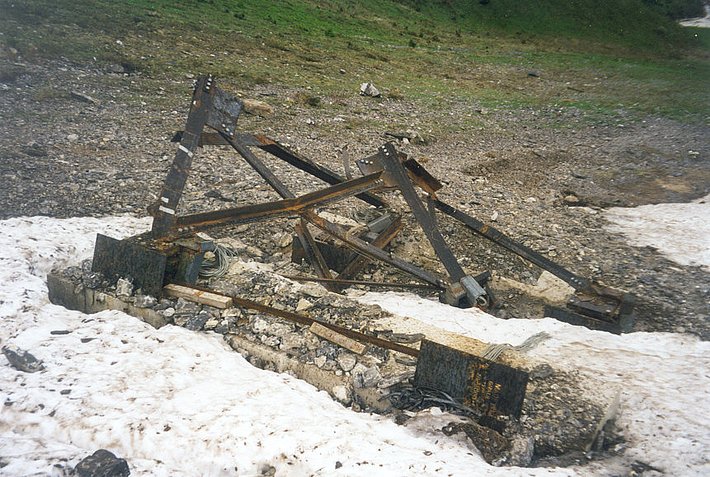
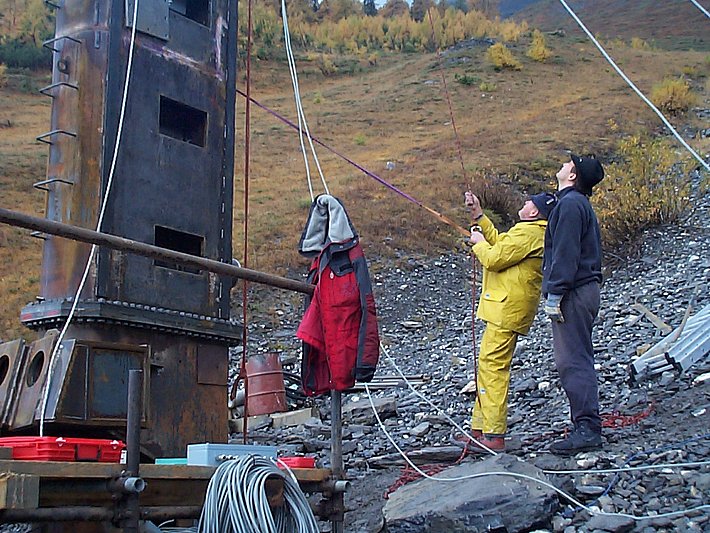
Experimental methods and devices
Doppler radars
The overall velocity of dense-flow and powder-snow avalanches, from release to deposition, is measured by Doppler radar technique. Two Doppler radar devices, appertaining to the Austrian partners are in operational use: radarhost7 and radarhost11. They differ in their maximal spatial range gate resolution (50 and 25m) and slightly in their measurement frequency (5.800 and 5.835GHz).
GEODAR
The dynamics of the avalanche front and internal surges are tracked using a Frequency Modulated Continuous Wave phased array radar (The GEODAR). This radar can image the denser parts and structures in the flow penetrating the powder cloud at a resolution of 0.75m at 111Hz.
Photogrammetry
The frontal speed of the avalanche is obtained also by photogrammetry. This technique is also used to map the evolution of the powder cloud and thus to determine the overall volume variations.
Optical sensors
Not only the avalanche surface velocity, but also the distribution of the internal flow velocity is particularly important in avalanche science, since it provides insight into the constitutive relations governing the avalanche motion. For this reason optical sensors are installed on the pylon in order to measure the velocity profile inside the avalanche.
Impact and air pressure sensors
Impact pressure sensors with dimensions from 0.1 to 1 m have been installed at the pylon, at the narrow wedge obstacle and at the small wall. Air pressure sensors (Pitot) are built into a specially designed housing unit and mounted on the top of the pylon to measure the air flow outside and inside powder snow avalanches
Temperature sensors
Infrared temperature sensors are installed at the pylon and measure fast variation of temperature inside the moving avalanche.
Capacitance probes
Capacitance probes for density measurements and flow height sensors complete the measurement setup at the pylon.
Laserscanning measurements
Knowledge of the mass balance of avalanches is a crucial factor in avalanche dynamics. In order to establish the mass balance of an avalanche, the snow distributions before and after the avalanche release have to be measured. Since it is too dangerous to directly measure the snow depths in the slope before the avalanche is triggered, remote sensing methods are applied. In the past, a method of helicopter based photogrammetry has been developed to measure the snow depths before and after the artificial avalanche release. Since 2006, this method has been substituted by high definition laserscanning measurements. In addition to the measurements by laserscanning, some field measurements are still necessary.
Frequency-modulated continuous-wave (FMCW) radars
To complete the mass balance measurements, three pairs of FMCW radar units are buried in the track, the highest at 2300 m a.s.l., the next one at 1900 m a.s.l. and the lowest one just above the obstacles. The FMCW radars help to determine erosion rates and flow height
Infrared measurements
During artificial releases, avalanches are filmed using an infrared camera in order to establish surface snow temperatures before, during and after the release.
